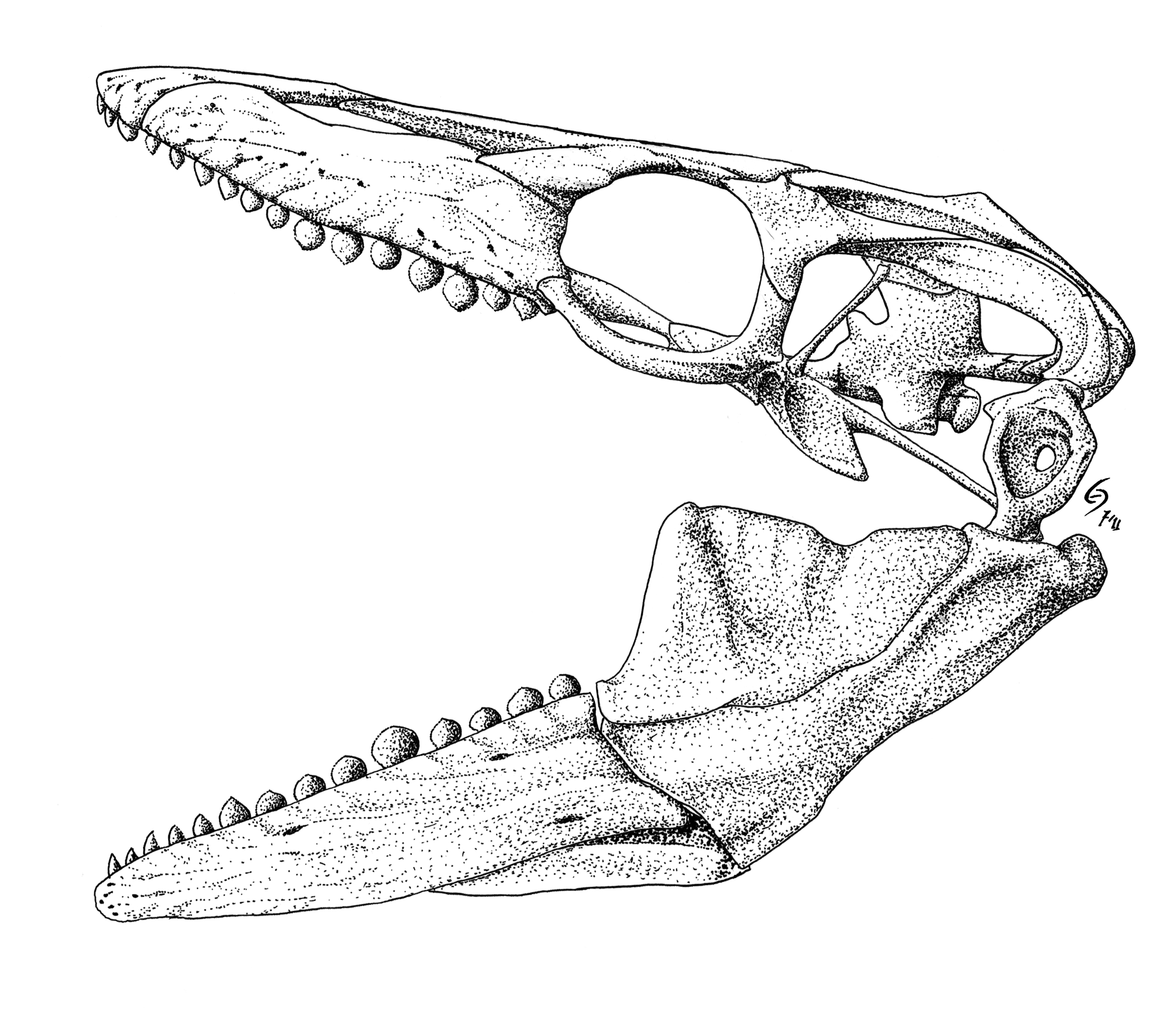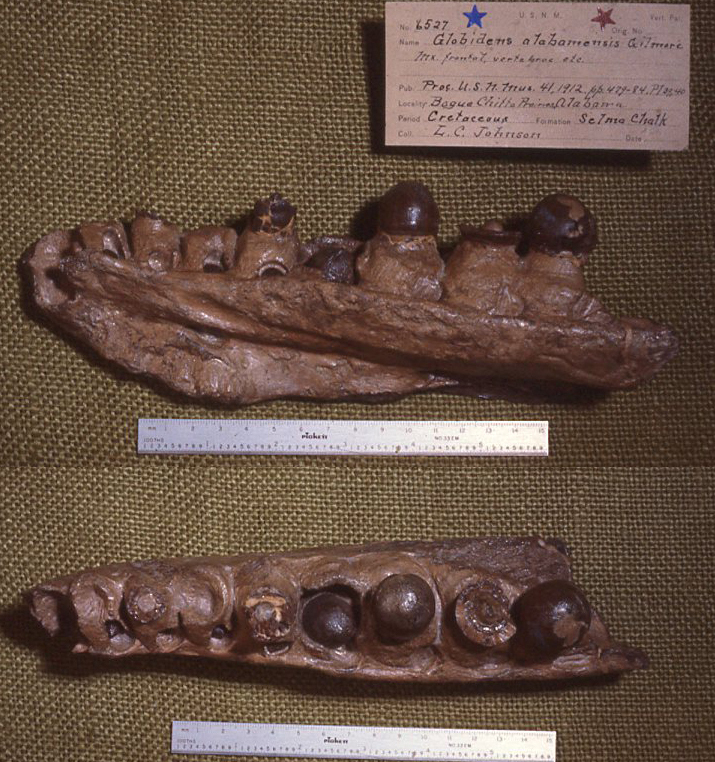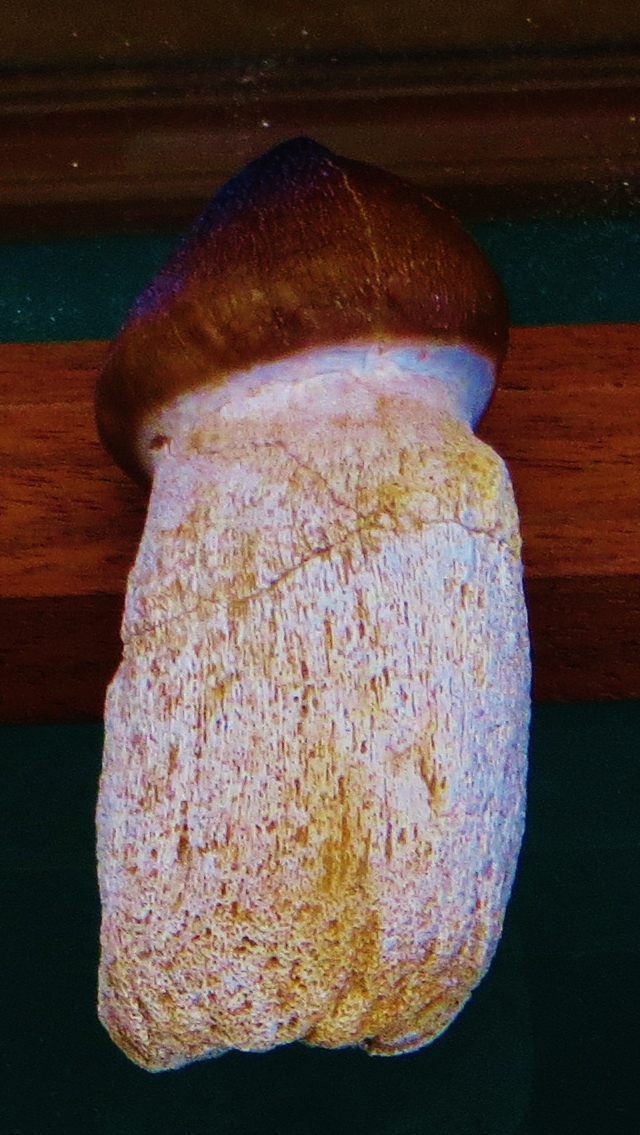Globidens on:
[Wikipedia]
[Google]
[Amazon]
''Globidens'' ("Globe teeth") is an extinct
 Studies since Gilmore's assessment establish more specific and more complete lists of diagnostic features. Gilmore correctly inferred that ''Globidens'' had a stout, powerfully built skull. In addition, a few notable skull characteristics include: a small parietal foramen, located entirely within the parietal; tuberosities present on the jugal; a longitudinal crest present on the dorsal surface of the frontal; and a
Studies since Gilmore's assessment establish more specific and more complete lists of diagnostic features. Gilmore correctly inferred that ''Globidens'' had a stout, powerfully built skull. In addition, a few notable skull characteristics include: a small parietal foramen, located entirely within the parietal; tuberosities present on the jugal; a longitudinal crest present on the dorsal surface of the frontal; and a
 *''Globidens alabamaensis'' Gilmore, 1912 - (''Type specimen'') Height of the tooth crown is less than the greatest tooth crown diameter behind the seventh maxillary tooth; crown length greater than crown width in front of the tenth maxillary tooth. The maxilla is long and the frontal narrow. Frontal bone slightly enters the orbits dorsally.
*''G. dakotaensis'' Russell, 1975 - Height of the tooth crown is less than the greatest tooth crown diameter behind the fourth maxillary tooth; crown length greater than crown width in front of the tenth maxillary tooth. The maxilla is long and the frontal broad. Frontal bone does not enter the orbits dorsally.
*''G. hisaensis'' Kaddumi, 2009 from central Jordan
*''G. phosphaticus'' Bardet et al. 2005 from Morocco and Angola.
*''G. simplex'' LeBlanc ''et al.'' 2019 from Morocco. A complete mandible and partial skull was recovered, showing large jaw adductor musculature attachment points indicative of hard shelled prey. A shortened dentary with respect to the Posterior Mandibular Unit relative to other globidensine mosasaurs supports this as well. Postcranial remains were also recovered, and histological analysis of one rib showed increased bone compactness reminiscent of conditions seen in early stages in marine tetrapod evolution, suggesting increased ability to stay submerged for long periods along the sea floor.
Further study or additional specimens may be necessary for the following:
*''G. schurmanni'' Martin, 2007
*''Globidens alabamaensis'' Gilmore, 1912 - (''Type specimen'') Height of the tooth crown is less than the greatest tooth crown diameter behind the seventh maxillary tooth; crown length greater than crown width in front of the tenth maxillary tooth. The maxilla is long and the frontal narrow. Frontal bone slightly enters the orbits dorsally.
*''G. dakotaensis'' Russell, 1975 - Height of the tooth crown is less than the greatest tooth crown diameter behind the fourth maxillary tooth; crown length greater than crown width in front of the tenth maxillary tooth. The maxilla is long and the frontal broad. Frontal bone does not enter the orbits dorsally.
*''G. hisaensis'' Kaddumi, 2009 from central Jordan
*''G. phosphaticus'' Bardet et al. 2005 from Morocco and Angola.
*''G. simplex'' LeBlanc ''et al.'' 2019 from Morocco. A complete mandible and partial skull was recovered, showing large jaw adductor musculature attachment points indicative of hard shelled prey. A shortened dentary with respect to the Posterior Mandibular Unit relative to other globidensine mosasaurs supports this as well. Postcranial remains were also recovered, and histological analysis of one rib showed increased bone compactness reminiscent of conditions seen in early stages in marine tetrapod evolution, suggesting increased ability to stay submerged for long periods along the sea floor.
Further study or additional specimens may be necessary for the following:
*''G. schurmanni'' Martin, 2007
 ''Globidens'' resides within the Subfamily Mosasaurinae, which includes several mosasaur lineages, and within that, the Tribe Globidensini, which also includes the genus '' Carinodens''. ''Carinodens'' is thus regarded as a sister taxon of ''Globidens''.
Placement of ''Globidens'' and, to an extent, Mosasauridae in a phylogenetic tree is somewhat unclear, and specific placement of genera varies between many morphological and molecular tests. It is generally agreed that Mosasauridae is a sister group to Pythonomorpha, which includes all snakes. Within Mosasauridae, ''Globidens'' is generally placed near ''Prognathodon'', although some placements of ''Prognathodon'' specimens are questionable.
Cladogram of mosasaurs and related taxa modified from Aaron R. H. Leblanc, Michael W. Caldwell and Nathalie Bardet, 2012:
''Globidens'' resides within the Subfamily Mosasaurinae, which includes several mosasaur lineages, and within that, the Tribe Globidensini, which also includes the genus '' Carinodens''. ''Carinodens'' is thus regarded as a sister taxon of ''Globidens''.
Placement of ''Globidens'' and, to an extent, Mosasauridae in a phylogenetic tree is somewhat unclear, and specific placement of genera varies between many morphological and molecular tests. It is generally agreed that Mosasauridae is a sister group to Pythonomorpha, which includes all snakes. Within Mosasauridae, ''Globidens'' is generally placed near ''Prognathodon'', although some placements of ''Prognathodon'' specimens are questionable.
Cladogram of mosasaurs and related taxa modified from Aaron R. H. Leblanc, Michael W. Caldwell and Nathalie Bardet, 2012:
genus
Genus ( plural genera ) is a taxonomic rank used in the biological classification of living and fossil organisms as well as viruses. In the hierarchy of biological classification, genus comes above species and below family. In binomial nom ...
of mosasaur lizard classified as part of the Globidensini tribe in the Mosasaurinae subfamily.
''Globidens alabamaensis'' was the first species of ''Globidens'' described, in a publication by Charles W. Gilmore (1912). It is used as the type specimen for ''Globidens''.
''Globidens'' belongs to the family Mosasauridae, which consists of several genera of predatory marine reptiles prevalent during the Late Cretaceous
The Cretaceous ( ) is a geological period that lasted from about 145 to 66 million years ago (Mya). It is the third and final period of the Mesozoic Era, as well as the longest. At around 79 million years, it is the longest geological period of ...
. Specimens of ''Globidens'' have been discovered in Syria
Syria ( ar, سُورِيَا or سُورِيَة, translit=Sūriyā), officially the Syrian Arab Republic ( ar, الجمهورية العربية السورية, al-Jumhūrīyah al-ʻArabīyah as-Sūrīyah), is a Western Asian country loc ...
, North America
North America is a continent in the Northern Hemisphere and almost entirely within the Western Hemisphere. It is bordered to the north by the Arctic Ocean, to the east by the Atlantic Ocean, to the southeast by South America and th ...
, Morocco
Morocco (),, ) officially the Kingdom of Morocco, is the westernmost country in the Maghreb region of North Africa. It overlooks the Mediterranean Sea to the north and the Atlantic Ocean to the west, and has land borders with Algeria to A ...
, Angola
, national_anthem = "Angola Avante"()
, image_map =
, map_caption =
, capital = Luanda
, religion =
, religion_year = 2020
, religion_ref =
, coordinat ...
, and Indonesia
Indonesia, officially the Republic of Indonesia, is a country in Southeast Asia and Oceania between the Indian and Pacific oceans. It consists of over 17,000 islands, including Sumatra, Java, Sulawesi, and parts of Borneo and New Gui ...
. Among mosasaurs, ''Globidens'' is probably most well known for its highly rounded, globe-like teeth.
Description
''Globidens'' was a relatively medium sized mosasaur, measuring long and weighing . It was similar in appearance to other mosasaurs (streamlined body with flippers, a laterally flattened tail and powerful jaws). Theteeth
A tooth ( : teeth) is a hard, calcified structure found in the jaws (or mouths) of many vertebrates and used to break down food. Some animals, particularly carnivores and omnivores, also use teeth to help with capturing or wounding prey, ...
of ''Globidens'' differed from those of other mosasaurs in being globular, giving rise to its generic name. Most mosasaurs had sharp teeth evolved to grab soft, slippery prey like fish
Fish are Aquatic animal, aquatic, craniate, gill-bearing animals that lack Limb (anatomy), limbs with Digit (anatomy), digits. Included in this definition are the living hagfish, lampreys, and Chondrichthyes, cartilaginous and bony fish as we ...
and squid, which in some later species were modified to rend flesh as well. While many other mosasaurs were capable of crushing the shells of ammonites, none were as specialized for dealing with armored prey as ''Globidens''. ''Globidens'' had semispherical teeth with rounded points suited for crushing tough armored prey such as small turtles, ammonites, nautili, and bivalves. Like its larger relative, '' Mosasaurus'', ''Globidens'' had a robustly built skull with tightly-articulating jaws that played a large role in the animal’s ability to penetrate the armor of its shelled prey.
Gilmore's initial assessment of ''Globidens'', based on an incomplete specimen of ''G. alabamaensis'', made note of characteristics observable in parts of the skull, the teeth, and one of the cervical vertebrae. He made note of a long snout with a large maxilla; a large, sturdy frontal bone
The frontal bone is a bone in the human skull. The bone consists of two portions.'' Gray's Anatomy'' (1918) These are the vertically oriented squamous part, and the horizontally oriented orbital part, making up the bony part of the forehead, ...
; and the characteristic globular teeth with finely wrinkled enamel. Gilmore concluded that the skull characters were similar to '' Platecarpus'' or, more closely, to ''Brachysaurus'' (currently '' Prognathodon'').
 Studies since Gilmore's assessment establish more specific and more complete lists of diagnostic features. Gilmore correctly inferred that ''Globidens'' had a stout, powerfully built skull. In addition, a few notable skull characteristics include: a small parietal foramen, located entirely within the parietal; tuberosities present on the jugal; a longitudinal crest present on the dorsal surface of the frontal; and a
Studies since Gilmore's assessment establish more specific and more complete lists of diagnostic features. Gilmore correctly inferred that ''Globidens'' had a stout, powerfully built skull. In addition, a few notable skull characteristics include: a small parietal foramen, located entirely within the parietal; tuberosities present on the jugal; a longitudinal crest present on the dorsal surface of the frontal; and a premaxilla
The premaxilla (or praemaxilla) is one of a pair of small cranial bones at the very tip of the upper jaw of many animals, usually, but not always, bearing teeth. In humans, they are fused with the maxilla. The "premaxilla" of therian mammal has ...
with a rostrum anterior to the premaxillary teeth. The rounded teeth with finely wrinkled enamel seen in ''Globidens'' are characteristic of Globidensini; however, the degree of rounding on individual teeth may be indicative of genus or even species. Marginal teeth in Globidens become most subspherical toward the center of the jaws. Additionally, ''Globidens'' had thirteen maxillary teeth, and either lacked or showed only rudimentary pterygoid dentition.
History of discovery
''Globidens'' was first described in 1912 by Charles W. Gilmore. Using an incomplete specimen consisting only of a partial skull with several teeth, a single cervical vertebra, and numerous fragments, Gilmore identified ''Globidens'' as a new genus, naming his type specimen ''Globidens alabamaensis''. The genus name was based on the globular structure of the specimen's teeth, and the species name on the location in which it was discovered. (It may be noted that the original location from which the specimen was taken is not precisely known, as Gilmore was examining a specimen that had been collected earlier.) Since Gilmore's identification of ''Globidens'', several other species have been identified, including ''G. dakotensis'' (Russel 1975), which currently is sometimes used as a secondary type specimen alongside ''G. alabamaensis''. Some specimens previously thought to be new species of ''Globidens'' have since been reassigned to other taxa such as ''Prognathodon'', or placed in a new taxa, such as ''G. aegypticus'' which is now a type specimen for ''Igdamanosaurus''.Species
 *''Globidens alabamaensis'' Gilmore, 1912 - (''Type specimen'') Height of the tooth crown is less than the greatest tooth crown diameter behind the seventh maxillary tooth; crown length greater than crown width in front of the tenth maxillary tooth. The maxilla is long and the frontal narrow. Frontal bone slightly enters the orbits dorsally.
*''G. dakotaensis'' Russell, 1975 - Height of the tooth crown is less than the greatest tooth crown diameter behind the fourth maxillary tooth; crown length greater than crown width in front of the tenth maxillary tooth. The maxilla is long and the frontal broad. Frontal bone does not enter the orbits dorsally.
*''G. hisaensis'' Kaddumi, 2009 from central Jordan
*''G. phosphaticus'' Bardet et al. 2005 from Morocco and Angola.
*''G. simplex'' LeBlanc ''et al.'' 2019 from Morocco. A complete mandible and partial skull was recovered, showing large jaw adductor musculature attachment points indicative of hard shelled prey. A shortened dentary with respect to the Posterior Mandibular Unit relative to other globidensine mosasaurs supports this as well. Postcranial remains were also recovered, and histological analysis of one rib showed increased bone compactness reminiscent of conditions seen in early stages in marine tetrapod evolution, suggesting increased ability to stay submerged for long periods along the sea floor.
Further study or additional specimens may be necessary for the following:
*''G. schurmanni'' Martin, 2007
*''Globidens alabamaensis'' Gilmore, 1912 - (''Type specimen'') Height of the tooth crown is less than the greatest tooth crown diameter behind the seventh maxillary tooth; crown length greater than crown width in front of the tenth maxillary tooth. The maxilla is long and the frontal narrow. Frontal bone slightly enters the orbits dorsally.
*''G. dakotaensis'' Russell, 1975 - Height of the tooth crown is less than the greatest tooth crown diameter behind the fourth maxillary tooth; crown length greater than crown width in front of the tenth maxillary tooth. The maxilla is long and the frontal broad. Frontal bone does not enter the orbits dorsally.
*''G. hisaensis'' Kaddumi, 2009 from central Jordan
*''G. phosphaticus'' Bardet et al. 2005 from Morocco and Angola.
*''G. simplex'' LeBlanc ''et al.'' 2019 from Morocco. A complete mandible and partial skull was recovered, showing large jaw adductor musculature attachment points indicative of hard shelled prey. A shortened dentary with respect to the Posterior Mandibular Unit relative to other globidensine mosasaurs supports this as well. Postcranial remains were also recovered, and histological analysis of one rib showed increased bone compactness reminiscent of conditions seen in early stages in marine tetrapod evolution, suggesting increased ability to stay submerged for long periods along the sea floor.
Further study or additional specimens may be necessary for the following:
*''G. schurmanni'' Martin, 2007
Reassigned species
*''Globidens aegyptiacus'' Zdansky, 1935; now type species of '' Igdamanosaurus''. *''Globidens fraasi'' Dollo 1913; now type species of '' Carinodens''. *''Globidens timorensis'' Huene, 1935; reinterpreted as aTriassic
The Triassic ( ) is a geologic period and system which spans 50.6 million years from the end of the Permian Period 251.902 million years ago ( Mya), to the beginning of the Jurassic Period 201.36 Mya. The Triassic is the first and shortest per ...
ichthyosaur
Classification
Paleobiology
''Globidens'' was uniquely adapted to take advantage of hard-shelled food resources in comparison to other mosasaurs. In addition to a generally robust skull, its teeth are adapted for crushing rather than piercing or tearing. It is believed that ''Globidens'' was a durophagous predator, eating mollusks such as bivalves andammonites
Ammonoids are a group of extinct marine mollusc animals in the subclass Ammonoidea of the class Cephalopoda. These molluscs, commonly referred to as ammonites, are more closely related to living coleoids (i.e., octopuses, squid and cuttlefis ...
. Stomach contents of a specimen found in South Dakota support prior assumptions, showing the crushed shells of inoceramid
The Inoceramidae are an extinct family of bivalves ("clams") in the Class Mollusca. Fossils of inoceramids are found in marine sediments of Permian to latest Cretaceous in age. Inoceramids tended to live in upper bathyal and neritic environments ...
clams.
Paleoecology
''Globidens'', like other mosasaurs, lived in warm, shallow seas such as the Western Interior Seaway in North America. So far, ''Globidens'' has been discovered primarily in North America and in parts of northern and western Africa, such as Morocco and Angola, although specimens from the Middle East and eastern South America have been found as well. InIndonesia
Indonesia, officially the Republic of Indonesia, is a country in Southeast Asia and Oceania between the Indian and Pacific oceans. It consists of over 17,000 islands, including Sumatra, Java, Sulawesi, and parts of Borneo and New Gui ...
, ''Globidens'' lived in Timor islandPolcyn, M. J., Jacobs, L. L., Schulp, A. S., and Mateus, O. 2010. The North African Mosasaur ''Globidens phosphaticus'' from the Maastrichtian of Angola. Historical Biology, 22(3):175-185.
See also
*List of marine reptiles
Following is a list of marine reptiles, reptiles which are adapted to life in marine or brackish environments.
Extant
The following marine reptiles are species which are currently extant or recently extinct.
Crocodiles
:*''Crocodylus''
::'' Cr ...
References
* Everhart, M.J. 2008. Rare occurrence of a ''Globidens'' sp. (Reptilia; Mosasauridae) dentary in the Sharon Springs Member of the Pierre Shale (Middle Campanian) of Western Kansas. p. 23-29 in Farley G. H. and Choate, J.R. (eds.), Unlocking the Unknown; Papers Honoring Dr. Richard Zakrzewski, Fort Hays Studies, Special Issue No. 2, 153 p., Fort Hays State University, Hays, KS. * Huene, E. von. 1935. Mosasaurier-Zähne von Timor. Centralblatt fur Mineralogie. Geologic und Palaeontologie; in Verbindung mit dens Neuen Jahrbuch fur Mineralogie, Geologie und Palaeontologie. Stuttgart. Abt. B 10 412-416, 3 figs. (in German) * Martin, J. E. 2007. A new species of the durophagous mosasaur, ''Globidens'' (Squamata: Mosasauridae) from the Late Cretaceous Pierre Shale Group of central South Dakota, USA. Pages 167-176 in Martin, J. E. and Parris D. C. (eds.), The Geology and Paleontology of the Late Cretaceous Marine Deposits of the Dakotas. Geological Society of America, Special Paper 427. (''Globidens schurmanni'') * Russell, Dale A. 1975. A new species of ''Globidens'' from South Dakota. Fieldiana Geology, 33(13): 235-256. (Field Museum of Natural History) {{Taxonbar, from=Q141401 Mosasaurines Mosasaurs of North America Fossil taxa described in 1912 Mosasaurs of Asia Mosasaurs of Africa Taxa named by Charles W. Gilmore Mooreville Chalk